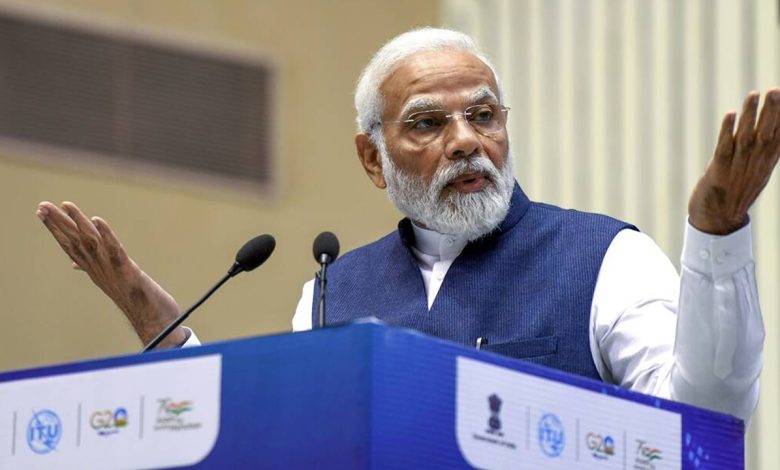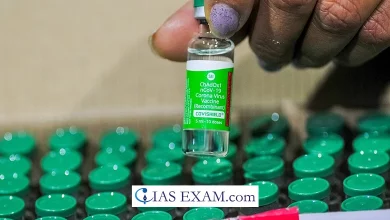
Context- In his recent speech to the One World TB Summit, the Prime Minister made plans to eradicate tuberculosis by 2025.
Key Highlights
- The Ministry of Health organizes the One World TB Summit to advance the Indian concept of “One Earth, One Health.”
- The PM announced the TB-Mukt Panchayat and shorter TB Preventive Treatment (TPT) in order to achieve the target of TB elimination by 2025.
- In addition, India was the first nation to develop a practical mathematical model for estimating TB.
- Participants from forty nations in the 36th Stop TB Partnership Board were shown the mathematical model.
TB Burden
- In 2021, the WHO estimates that 1.6 million people will die from tuberculosis, including 187 000 HIV-positive individuals.
- TB is the 13th leading cause of death worldwide and the second leading infectious disease, after COVID-19 (behind HIV/AIDS).
- Around 85% of people who develop the disease can be successfully treated with a four- to six-month drug regimen.
- India is responsible for more than a quarter of all TB cases worldwide.
- India’s TB report for 2023 says: There were 24.2 lakh cases reported in 2022, a 13% increase over 2021.
Global Tuberculosis Report
- The World Health Organization published its 2022 version of the Global Tuberculosis Report.
- At the global, regional, and national levels, it provides a comprehensive and up-to-date assessment of the TB epidemic as well as progress in its prevention, diagnosis, and treatment.
The Report’s Standout Points:
- Cases increase: In 2021, an estimated 10.6 million people were diagnosed with tuberculosis (TB), a 4.5 percent increase from 2020, and 1.6 million died from the disease (including 1,87,000 HIV-positive individuals).
- Assessment by country: India was one of eight countries that had more than two thirds (or 68.3%) of the total number of TB patients, with 28% of cases.
- Indonesia had 9.2% cases, while China had 7.4%, the Philippines had 7%, Pakistan had 5.8%, Nigeria had 4.4%, Bangladesh had 3.6%, and the Democratic Republic of the Congo had 2.9%.
- The prevalence of drug-resistant tuberculosis (DR-TB) also increased by 3% between 2020 and 2021, with 4, 50,000 new RR-TB cases in 2021.
- This is the first time in many years that an increase in the number of people who become ill with tuberculosis and drug-resistant tuberculosis has been reported.
- Without a diagnosis: Many people with TB have not received a diagnosis or treatment because of ongoing difficulties in providing essential TB services and gaining access to them. Globally, underreporting persists as a major issue.
- Global Problems: For vulnerable populations, ongoing conflicts in Eastern Europe, Africa, and the Middle East have made the situation even worse.
- India alone was responsible for 36% of the global TB deaths involving HIV-negative individuals, accounting for nearly 82% of the total.
Government Initiatives
- Under the Ayushman Bharat Digital Health Mission, the government has begun utilizing technology by creating digital health IDs for TB patients to guarantee proper diagnosis and treatment.
- Through direct benefit transfer to patients, Ni-kshay Poshan Yojana provides financial assistance.
- Pradhan Mantri TB Mukt Bharat Abhiyan: To achieve the nation’s goal of ending the TB epidemic by 2025—five years ahead of the Sustainable Development Goals (SDG) for 2030.
- National TB Elimination Program: It is a Ministry of Health and Family Welfare (MOHFW) initiative to accelerate the country’s progress toward eliminating tuberculosis by 2025. It provides additional patient support to improve TB patients’ treatment outcomes.
- TB Mukt Gram Panchayat Abhiyaan: TB Mukt Gram Panchayat abhiyaan plans to include the local area to understand the objective of TB elimination.it accommodates TB Champions who have been recognized and sharpened on TB at the Panchayat level .
- Inclusion of Bacillus Calmette–Guérin (BCG) vaccine in the Indradhanush program.
- MIP (Mycobacterium Indicus Pranii) and VPM (Vaccine Projekt Management) 1002 are two vaccines that have been developed and are currently undergoing clinical trials.
- Model of Tuberculosis: India has fostered a numerical model for better assessment of the infection
- Utilizing this model, TB frequency and mortality gauge information for India will be accessible by Spring consistently, months before the yearly WHO gauges. India can likewise get ready comparative appraisals at the state level involving the model in future
Challenges
- Malnutrition: According to data from a number of different organizations, about 16.4% of the people in India are poor, with 4.2% living in extreme poverty because their deprivation score is higher than 50%.
- Problems of undernourishment and poor and unsanitary living are linked to poverty.
- Under-reporting of cases of tuberculosis is one of the main reasons why TB is so common in India.
- As a result, there is a possibility of contracting TB from healthy individuals.
- Treatment: In the fight against tuberculosis, unequal access to high-quality diagnostics and treatments remains a major issue.
- Additionally, the private sector, which is responsible for a significant portion of TB care, is dispersed, includes a variety of healthcare providers, and is largely unregulated.
- Drug resistance to TB: Standard TB treatment is not followed consistently across the private sector, leading to an increase in drug resistance.
- Issues with RNCTP: Another major concern is how poorly the Revised National TB Control Program is implemented at the state level.
- Stigma in society: Patients frequently wonder whether or not to look for treatment or keep their condition through and through for dread from getting social segregation and criticism.
Way Ahead
- India must employ a multifaceted strategy that places an emphasis on the creation of vaccines, the incorporation of technology, and community efforts into the TB treatment regimen.
TB
- Mycobacterium tuberculosis is the bacterium that causes tuberculosis (TB).
- Pulmonary TB is the most common form of tuberculosis in humans, but extra-pulmonary TB can also affect other organs.
- Through the air, TB can spread from one person to another.
- Coughing up blood and sometimes sputum, chest pain, weakness, weight loss, fever, and night sweats are common signs.
- The disease affects the majority of adults.
- Men, adult women, and children accounted for 56.5 percent of the TB burden in 2021.
- Five risk factors are responsible for many new cases of tuberculosis:
- Diabetes, malnutrition, HIV, and alcoholism and other substance abuse problems.
- TB can be prevented and treated, and around 85% of people who get the disease can be successfully treated with a drug regimen that lasts four to six months.
- The treatment also has the added benefit of preventing further infection transmission.
- There are cases of tuberculosis worldwide, but 30 countries have the highest prevalence.
- On March 24, World Tuberculosis (TB) Day is observed to raise awareness of the devastating health, social, and economic effects of TB and to take action to end the global TB epidemic.
- On this day, Dr. Robert Koch made the announcement that he had discovered the TB-causing Mycobacterium tuberculosis. His discovery paved the way for the disease’s diagnosis and treatment.





.png)



